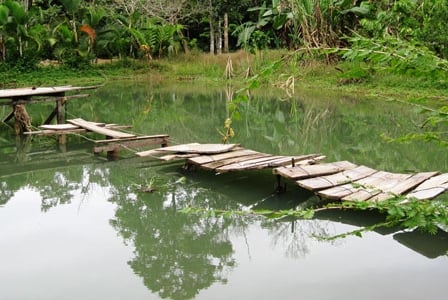
Not only are we destroying medicinal plants and precious habitat, were changing the worlds weather systems. Thats why rainforest conservation impacts us all.
alive senior editor Ellen Niemer discovered why rainforest conservation is so important when she visited Finca Luna Nueva and the Children’s Eternal Rainforest in Costa Rica.
In July, I wrote about my trip to Finca Luna Nueva where I visited the first Sacred Seeds Garden.
I also had the opportunity to explore the surrounding rainforest.
In my mind, I pictured the tropical rainforest as a dark impenetrable jungle of entwined trees, vines, and snakes hanging menacingly from branches ready to hypnotize me with mesmerizing eyes like Kaa of The Jungle Book. I’m happy to report that I didn’t meet any hypnotizing snakes, despite the pictures of local snakes displayed outside the door of my room.
Sights and sounds galore
But what I did see—and hear—was a riotous diversity of life: vines climbing up trees in a quest for sunlight, amazing tree roots that protruded like long witches’ fingers, bird calls of a variety and tonal range I’d never heard before, and at night the loud cacophony of the howler monkeys, whose howls can apparently travel three miles through dense forest.
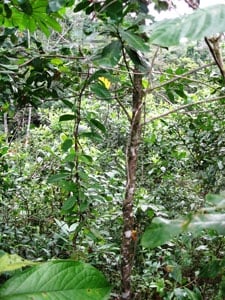

My guides for my treks through the rainforest were Tom and Terry Newmark.

A step back in time
My heart beat a little faster when we approached the rainforest adjacent to Finca Luna Nueva for the first time. Tom said, “Set your watch back 5 million years!”
Despite the age of the rainforest itself, the individual trees live no more than 100 to 150 years. Tom said it’s because the soil in the rainforest lacks nutrients—the topsoil extends only a few inches deep. But the rainforest near Finca Luna Nueva is richer than most. Due to its proximity to the Arenal Volcano, the soil’s been enriched by nutrient-rich volcanic ash.
An abundance of life
Tropical rainforests are estimated to cover about 2 percent of the Earth’s total surface or about 6 percent of the Earth’s land surface, but they disproportionately house 50 percent of the world’s plants and animals.
According to the Nature Conservancy, a 4 square mile area of rainforest typically contains
- 1,500 flowering plants
- 750 species of trees
- 400 species of birds
- 150 species of butterflies
Medicinal properties
As we hiked through the rainforest, Tom pointed out various trees and vines. He asked for my room key and scraped away a bit of bark on a copal tree. The aromatic whitish liquid that ran out of the small hole was incense, similar to frankincense.

Walking through the rainforest is like walking through a giant natural medicine cabinet: more than 2,000 of its plants contain anti-cancer properties.
Destructive forces
Despite the abundance of life in the rainforest, its trees are being cut down relentlessly. Tom said that every minute one acre of rainforest is destroyed. A more pessimistic estimate is provided by the Rainforest Alliance. They estimate that 100 acres, or 2,000 trees, are being cut down each minute to make way for farming, ranching, logging, and mining.
By diminishing the rainforest, we diminish the quality of life on Earth. Besides providing a habitat for a large diversity of plants and animals, rainforests do much more.
Regulate climate
The trees of the rainforest act like sponges, storing water they draw from the forest floor and releasing it in the atmosphere as clouds and mist. They help prevent drought, which helps prevent famine.
Prevent soil erosion
The trees and plants store nutrients. When trees die and decay, their nutrients are recycled into the soil. When we remove the trees, we remove the nutrients they contain, leaving the soil depleted. Tree roots also hold the soil together while the forest canopy prevents heavy rain from washing soil away.
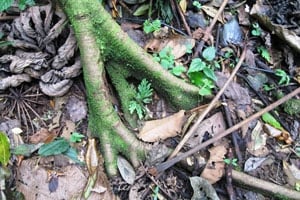
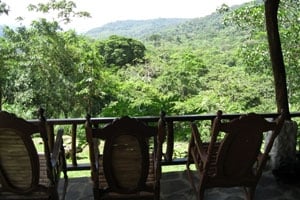
Provide a home
Indigenous peoples have been living in rainforests for centuries. When they’re displaced by modern activities such as logging, ranching, or mining, they lose their homes and their traditional way of life.
On our rainforest walk, we saw dirt roads that had been slashed through the forest by poachers who brazenly steal medicinal plants. But we also witnessed the miracle of how quickly the rainforest can regenerate itself through reforestation projects.
Building a corridor
We took a short bus ride to a piece of land that Tom, Terry, and other volunteers had replanted five years ago. They hadn’t been back to see the results. Euphoria is how I’d describe Tom’s reaction to the proliferation of growth.
The area they originally planted was a meadow. But the meadow is now a thick forest with a diversity of trees and plant life. Our guides even carried machetes to hack our way through the path where necessary.
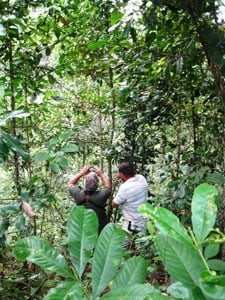
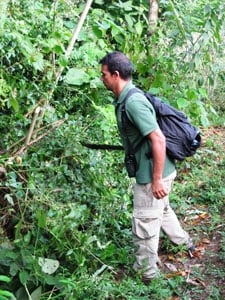
Thanks to the generous support of fundraising drives by New Chapter, Whole Foods Market, and Sprouts Farmers Market (some of whose staff accompanied us on our trek), biological corridors are being planted. By restoring the forest, animals such as jaguars and pumas are able to return to the rainforest. They need a huge area to live and hunt in, and they can’t breed and thrive when they’re confined to a small area. The return of large predators is the sign of a healthy ecosystem.
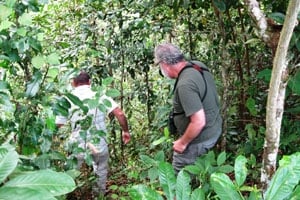
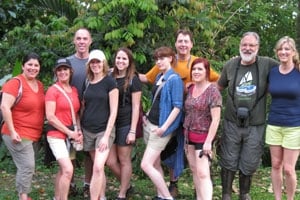
Be sure to check out the September print issue of alive to read my article about the conservation work being done at the Children’s Eternal Rainforest—a rainforest purchased by the fundraising efforts of children from 44 countries.

